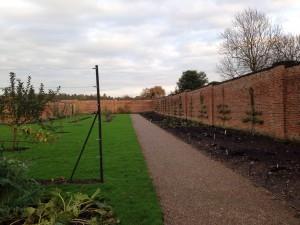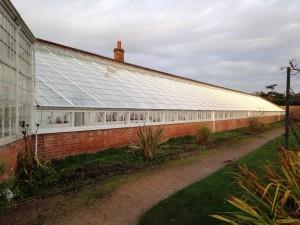It's one of the few remaining aspects of Clumber Park that reminds us how it once looked 100 years ago. Steeped in history, the Walled Kitchen Garden is maintained using traditional gardening techniques and is one of only a handful of its kind still in existence.
Clumber was once a huge estate belonging to the Newcastle family who occupied a grand mansion on the site. Previously known as the Newcastle estate, the Kitchen Garden was used to grow fruit and vegetables and the family helped in the original build of the glass house that we see today.
The glass house has suffered damage over its lifetime and in the 1970s became unrecognizable as it was left unkempt for long periods. Luckily, in 2006, the site underwent its first of several restorations, with the conservatory and west range restored to their former glory. This year, work was carried out to restore the east range, thanks to some magnificent fundraising efforts and the contribution of a £49,300 Heritage Lottery grant.
I visited Clumber recently to see the fruits of the team's recent labours. My tour guide was  Christopher Margrave, the Head Gardener, responsible for the up-keep of the Walled Kitchen Garden. His enthusiasm and dedication was apparent straight away as we walked through the glass conservatory and out into the expansive garden. His knowledge of the hundreds of types of fruit and vegetables grown here is astounding, as too is his expertise on how to grow them. Everything from the best time of year for planting, to the location within the garden that captures the most suitable amount of light or shade is on the tip of his tongue.
Chris is proud of what they have and rightly so. From the famous Nottinghamshire Bramley Apple, to rare or tropical varieties of fruit and veg you can't find in your typical garden centre, the Walled Kitchen garden has it all. In fact this year, the apple collection here which currently boasts 72 different varieties, has been recognised as being of national importance by the UK plant conservation organisation Plant Heritage and designated as a UK National Plant Collection. Another impressive feat achieved by Chris and his team is that they officially have the largest Rhubarb collection in Britain, with 137 different varieties.
For Chris and the team, education is pivotal to the work they do. Everything is clearly labelled, meaning that visitors can learn while they walk around. The methods of growing haven't changed much either, nor has the produce that comes out the garden. If one of the gardeners finds evidence of something that used to be grown here such as a metal label buried beneath the earth, their next step is to ensure this variety is grown here. Heritage lives within the work they do every day. Everything grown here is also used in the cafe, making it even more self-sufficient.
The glass house itself looks fantastic. It's rare to find one of these today so its maintenance
Christopher Margrave, the Head Gardener, responsible for the up-keep of the Walled Kitchen Garden. His enthusiasm and dedication was apparent straight away as we walked through the glass conservatory and out into the expansive garden. His knowledge of the hundreds of types of fruit and vegetables grown here is astounding, as too is his expertise on how to grow them. Everything from the best time of year for planting, to the location within the garden that captures the most suitable amount of light or shade is on the tip of his tongue.
Chris is proud of what they have and rightly so. From the famous Nottinghamshire Bramley Apple, to rare or tropical varieties of fruit and veg you can't find in your typical garden centre, the Walled Kitchen garden has it all. In fact this year, the apple collection here which currently boasts 72 different varieties, has been recognised as being of national importance by the UK plant conservation organisation Plant Heritage and designated as a UK National Plant Collection. Another impressive feat achieved by Chris and his team is that they officially have the largest Rhubarb collection in Britain, with 137 different varieties.
For Chris and the team, education is pivotal to the work they do. Everything is clearly labelled, meaning that visitors can learn while they walk around. The methods of growing haven't changed much either, nor has the produce that comes out the garden. If one of the gardeners finds evidence of something that used to be grown here such as a metal label buried beneath the earth, their next step is to ensure this variety is grown here. Heritage lives within the work they do every day. Everything grown here is also used in the cafe, making it even more self-sufficient.
The glass house itself looks fantastic. It's rare to find one of these today so its maintenance  is crucial. There are few walled gardens in the country which have a traditional glasshouse running their entire width so the one we have at Clumber really is a treasure and I'm delighted to say, it's looking better than it ever has done. Rot had begun to set in and the harsh storms of last winter had taken their toll on the glass roof. Here's a few statistics on the Walled Kitchen Garden restoration:
is crucial. There are few walled gardens in the country which have a traditional glasshouse running their entire width so the one we have at Clumber really is a treasure and I'm delighted to say, it's looking better than it ever has done. Rot had begun to set in and the harsh storms of last winter had taken their toll on the glass roof. Here's a few statistics on the Walled Kitchen Garden restoration:
 Christopher Margrave, the Head Gardener, responsible for the up-keep of the Walled Kitchen Garden. His enthusiasm and dedication was apparent straight away as we walked through the glass conservatory and out into the expansive garden. His knowledge of the hundreds of types of fruit and vegetables grown here is astounding, as too is his expertise on how to grow them. Everything from the best time of year for planting, to the location within the garden that captures the most suitable amount of light or shade is on the tip of his tongue.
Chris is proud of what they have and rightly so. From the famous Nottinghamshire Bramley Apple, to rare or tropical varieties of fruit and veg you can't find in your typical garden centre, the Walled Kitchen garden has it all. In fact this year, the apple collection here which currently boasts 72 different varieties, has been recognised as being of national importance by the UK plant conservation organisation Plant Heritage and designated as a UK National Plant Collection. Another impressive feat achieved by Chris and his team is that they officially have the largest Rhubarb collection in Britain, with 137 different varieties.
For Chris and the team, education is pivotal to the work they do. Everything is clearly labelled, meaning that visitors can learn while they walk around. The methods of growing haven't changed much either, nor has the produce that comes out the garden. If one of the gardeners finds evidence of something that used to be grown here such as a metal label buried beneath the earth, their next step is to ensure this variety is grown here. Heritage lives within the work they do every day. Everything grown here is also used in the cafe, making it even more self-sufficient.
The glass house itself looks fantastic. It's rare to find one of these today so its maintenance
Christopher Margrave, the Head Gardener, responsible for the up-keep of the Walled Kitchen Garden. His enthusiasm and dedication was apparent straight away as we walked through the glass conservatory and out into the expansive garden. His knowledge of the hundreds of types of fruit and vegetables grown here is astounding, as too is his expertise on how to grow them. Everything from the best time of year for planting, to the location within the garden that captures the most suitable amount of light or shade is on the tip of his tongue.
Chris is proud of what they have and rightly so. From the famous Nottinghamshire Bramley Apple, to rare or tropical varieties of fruit and veg you can't find in your typical garden centre, the Walled Kitchen garden has it all. In fact this year, the apple collection here which currently boasts 72 different varieties, has been recognised as being of national importance by the UK plant conservation organisation Plant Heritage and designated as a UK National Plant Collection. Another impressive feat achieved by Chris and his team is that they officially have the largest Rhubarb collection in Britain, with 137 different varieties.
For Chris and the team, education is pivotal to the work they do. Everything is clearly labelled, meaning that visitors can learn while they walk around. The methods of growing haven't changed much either, nor has the produce that comes out the garden. If one of the gardeners finds evidence of something that used to be grown here such as a metal label buried beneath the earth, their next step is to ensure this variety is grown here. Heritage lives within the work they do every day. Everything grown here is also used in the cafe, making it even more self-sufficient.
The glass house itself looks fantastic. It's rare to find one of these today so its maintenance  is crucial. There are few walled gardens in the country which have a traditional glasshouse running their entire width so the one we have at Clumber really is a treasure and I'm delighted to say, it's looking better than it ever has done. Rot had begun to set in and the harsh storms of last winter had taken their toll on the glass roof. Here's a few statistics on the Walled Kitchen Garden restoration:
is crucial. There are few walled gardens in the country which have a traditional glasshouse running their entire width so the one we have at Clumber really is a treasure and I'm delighted to say, it's looking better than it ever has done. Rot had begun to set in and the harsh storms of last winter had taken their toll on the glass roof. Here's a few statistics on the Walled Kitchen Garden restoration:
- At 450feet/130metres, it's the longest glasshouse in the care of the National Trust.
- 2,016 panes of glass have been cleaned for re-use. Their total surface area is 4,489 square feet and the panes are held with 8,064 metal pins and 4,032 straps
- 126 wooden glazing bars and 42 capping pieces have been manufactured. Their total length is 975 metres – nearly 1 kilometre
- Each glazing bar and capping piece has been painted four times, a total length of 3.9 kilometres. This would be more than enough to paint a 4 inch wide continuous white line along Clumber’s Lime Tree Avenue, which is a mere 3.2 kilometres long.
Related
0 Comments
Comments
Comments are disabled for this post.

 to add an item to your Itinerary basket.
to add an item to your Itinerary basket.










